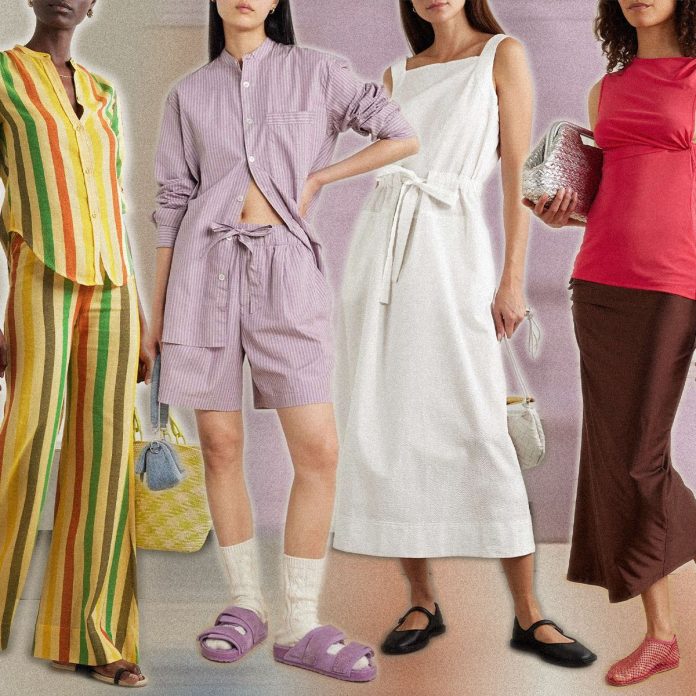## Fashion Through the Decades: 1960s – 1970s
### 1960s
#### Early 1960s: Echoes of the 1950s
In the early 1960s, fashion retained much of the 1950s elegance. First Lady Jacqueline Kennedy emerged as a style icon, epitomizing sophisticated chic. Major designers of this period included Hubert de Givenchy and Cristobal Balenciaga, who championed feminine, polished looks that emphasized grace and simplicity.
#### Mid-1960s: The Swinging Sixties
By the mid-1960s, fashion underwent a dramatic transformation, embracing the spirit of the “Swinging Sixties” – a cultural phenomenon celebrating youth, music, and modernity. Designers like Mary Quant, André Courrèges, Pierre Cardin, and Paco Rabanne revolutionized women’s fashion with daring, practical, and playful designs that often challenged conventional gender norms.
One of the most iconic inventions of this era was the miniskirt, credited to both Mary Quant and André Courrèges. Mary Quant also contributed to the sexual liberation of women with her introduction of trousers and hotpants. Yves Saint Laurent made a significant impact with the first tuxedo for women, further popularizing androgynous looks. The era’s most iconic model was Twiggy, whose androgynous appearance epitomized the decade’s fashion trends.
#### Innovative Materials and Bright Colors
The 1960s saw the introduction of new materials like acrylics, polyesters, PVC (polyvinyl chloride), vinyl, lycra, and metallics. Bright colors replaced the more subdued palette of previous decades, adding vibrancy and excitement to fashion.
#### Futuristic and Geometric Inspirations
Designers drew inspiration from space travel and technology, leading to futuristic fashion trends. André Courrèges’s “Moon boots” and Paco Rabanne’s “12 unwearable dresses” collection from 1966 are prime examples. Pierre Cardin, influenced by Pop Art and Op Art, experimented with motifs, geometry, and colors, creating landmark pieces like the “Egg carton dress” from his 1968 “Cosmocorps” collection and the “Bubble dress.” Courrèges also explored geometric shapes, cutting his garments into squares, triangles, and trapezoids, challenging traditional femininity.
#### Late 1960s: The Hippie Aesthetic Emerges
Towards the end of the 1960s, fashion began transitioning to the hippie aesthetic, a precursor to the 1970s hippie movement. This style rejected mainstream fashion, embracing a more free-spirited and eclectic approach.
### 1970s
#### Early 1970s: The Hippie Influence
The early 1970s continued the hippie trend that began in the late 1960s. Prairie dresses, patchwork, crochet, knitting, embroidery, and synthetic materials characterized this period. The 1970s became known as the “Polyester Decade” due to the widespread use of synthetic fabrics.
#### Mid-1970s: Glamour and Disco
As the decade progressed, the glamorous looks of the disco era began to dominate fashion. Designer Halston became a leading figure, known for his sleek and sophisticated styles that embodied the disco aesthetic.
#### Embracing Sexual Freedom and Vintage Inspiration
Designers also responded to the era’s sexual freedom. In 1971, Yves Saint Laurent launched his 1940s-inspired “Libération” collection, and Diane Von Furstenberg introduced her timeless “Wrap dress,” which became a symbol of female empowerment.
#### The Rise of Sportswear
The 1970s also saw a resurgence of sportswear in women’s fashion. Norma Kamali popularized this trend with her iconic “Sleeping bag coat,” sweats, and the “Parachute” collection of dresses and jumpsuits, blending practicality with style.
—
### Key Fashion Icons and Innovations
– **Jacqueline Kennedy:** Early 1960s style icon.
– **Twiggy:** Androgynous supermodel of the 1960s.
– **Mary Quant and André Courrèges:** Pioneers of the miniskirt.
– **Yves Saint Laurent:** Introduced the tuxedo for women.
– **Halston:** Leading designer of the disco era.
– **Diane Von Furstenberg:** Creator of the wrap dress.
– **Norma Kamali:** Innovator in sportswear fashion.
### Notable Designs and Trends
– **Miniskirt:** Symbol of 1960s fashion freedom.
– **PVC and Vinyl Clothing:** Reflecting the era’s fascination with new materials.
– **Geometric Shapes:** Courrèges’s architectural approach to design.
– **Disco Fashion:** Glamorous and sophisticated styles of the late 1970s.
– **Wrap Dress:** A timeless symbol of women’s empowerment.
This overview captures the essence of fashion in the 1960s and 1970s, highlighting key designers, trends, and cultural shifts that defined these transformative decades.

